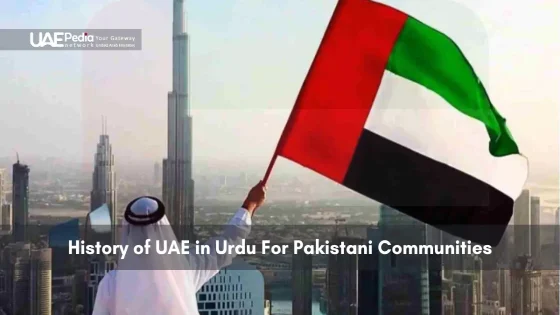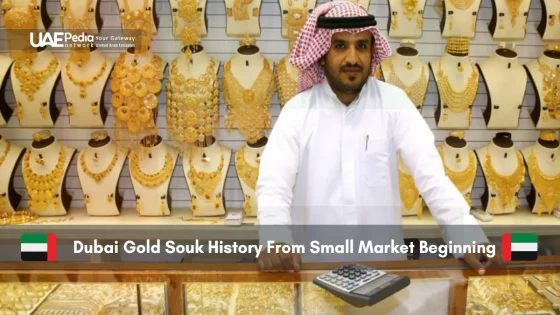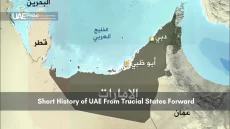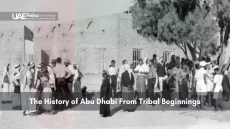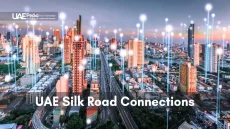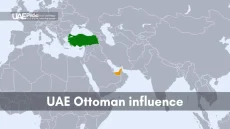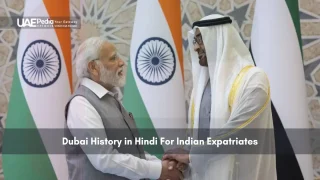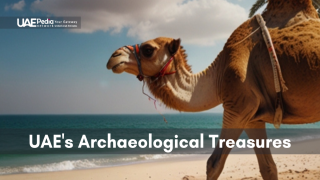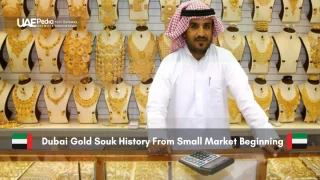Did you know ancient trading routes once linked the Arabian Peninsula’s sands to South Asia’s vibrant bazaars? Today, Pakistani communities in the UAE carry forward this legacy—bridging languages, traditions, and shared horizons. This isn’t just about dates or dusty artifacts. It’s about understanding how desert pearls became global icons while honoring roots that stretch across continents.
We’re unpacking the Emirates’ journey with Urdu-speaking readers in mind. Think archaeological wonders whispering tales of pearl divers, bold leaders uniting seven emirates, and oil transforming dunes into innovation hubs. Alongside facts, we’ll spotlight cultural threads that bind Pakistani expats to this land—from workplace rights to community milestones.
Why does this matter? Because stories shape belonging. Whether you’re planning a visit, working here, or simply curious, knowing a nation’s past adds depth to every skyline view. Consider this your trusted companion—like a friend explaining local customs over karak chai.
What you’ll uncover:
- Key moments that reshaped the region’s identity
- How Urdu speakers contribute to modern Emirati society
- Practical insights for navigating life here with confidence
The Cultural Tapestry of the United Arab Emirates
Imagine walking through a bustling souk where Arabic coffee aromas mingle with Bollywood beats—this is today’s Emirates. The nation thrives as a living mosaic, weaving Bedouin traditions with global flavors. Historic homes, like those preserved at desert forts, stand shoulder-to-shoulder with glass towers, whispering tales of resilience.
Local customs shape daily life here. Families gather in majlis spaces for heartfelt conversations, while artists fuse calligraphy with digital designs. Festivals like Dubai Shopping Festival and Sharjah Heritage Days spotlight this blend—traditional dances share stages with AI-powered light shows.
| Tradition | Modern Influence | Significance |
|---|---|---|
| Falconry | Robotic competitions | Honors skill & innovation |
| Henna art | 3D-printed designs | Bridges generations |
| Pearl diving | Luxury yacht culture | Connects past prosperity |
Reputable websites document these shifts, from UNESCO-listed sites to viral TikTok tours. Did you know the Emirates holds a Guinness World Record for the largest Arabic coffee cup? Such milestones mirror its ambition to honor roots while chasing futures.
For Urdu speakers, this cultural fluidity feels familiar—like adding cardamom to karak chai. Communities celebrate Eidiya during Eid and Diwali lights in Dubai’s lanes, proving traditions adapt without fading. As one elder told us: “Our doors stay open, but our floors remember ancestors’ footsteps.”
Early Human Habitation and Prehistoric Evidence
Long before skyscrapers dotted the horizon, ancient footsteps left their mark on these sands. Archaeologists uncovered hand-crafted stone tools at Jebel Faya—artifacts whispering tales of human survival from 125,000 years ago. These discoveries rewrite our understanding of early migration routes across Arabia.
Archaeological Discoveries and Stone Tools
Sharjah’s Mleiha Archaeological Center holds secrets older than pyramids. Flint hand-axes and scrapers found here reveal how early humans adapted to harsh environments. One archaeologist noted: “Each tool tells a story—of hunting, crafting, and relentless innovation.” Sites like these, documented in archived original April reports, connect modern Emirates to its ancient roots.
Climatic Influences on Early Settlements
Imagine the region 130,000 years ago—lush grasslands instead of dunes. Shifting rainfall patterns created temporary “green corridors,” drawing hunter-gatherers from Africa. Fossilized animal bones and pollen samples, highlighted in United Arab Emirates research hubs, prove this landscape once supported life abundantly.
These early pioneers didn’t just survive—they laid groundwork for trade networks that later moved copper, pearls, and ideas. Their legacy? A reminder that adaptation isn’t new here… it’s in the DNA.
Bronze Age Marvels: Umm Al Nar and Wadi Suq Cultures
Picture this: 4,000 years ago, artisans in what’s now Abu Dhabi crafted stone seals that reached Mesopotamia’s markets. The Umm Al Nar and Wadi Suq cultures didn’t just survive the Bronze Age—they thrived through trade, innovation, and storytelling etched into circular tombs.
Trade Routes and Cultural Exchange
Copper from Hajar Mountains flowed to distant lands via dhows loaded with dates and pearls. Archaeologists found Indus Valley pottery in Umm Al Nar sites—proof of a bustling exchange network. One researcher from the archived original December report put it best: “These weren’t mere traders. They were cultural translators.”
| Culture | Time Period | Key Features |
|---|---|---|
| Umm Al Nar | 2600–2000 BCE | Circular tombs, copper exports |
| Wadi Suq | 2000–1300 BCE | Innovative ceramics, expanded trade |
The archived original February notes reveal intricate jewelry designs blending local and Mesopotamian styles. Coastal settlements became hubs where Bedouin herders traded with sailors from Oman and beyond. Families buried loved ones in beehive-shaped graves filled with imported treasures—a testament to prosperity.
Recent digs, detailed in archived original June records, uncovered bronze spearheads alongside Indus Valley beads. These finds paint a picture of societies valuing both warfare and artistry. As you walk modern Dubai’s ports today, remember—the spirit of exchange began with Bronze Age visionaries.
The Transition to the Iron Age and Fortified Settlements
What if the desert’s harshness sparked innovation instead of defeat? Around 1,200 BCE, communities here answered that question with stone fortresses and water wizardry. Archaeologists found Iron Age settlements like Hili’s towering walls—not just for defense, but to protect lifelines: falaj irrigation channels snaking underground to nourish crops.
These gravity-fed systems transformed survival. Imagine farmers directing scarce rainfall through tunnels—engineering feats detailed in archived original September studies. One researcher quips: “They didn’t just adapt to the climate—they outsmarted it.” Villages grew into hubs where blacksmiths forged iron tools alongside date harvests.
Key shifts defined this era:
- Fortified towns replacing temporary camps
- Expanded trade networks moving metals, pottery
- Leadership models valuing collective problem-solving
Metallurgy advanced too. Artisans crafted arrowheads and jewelry, their techniques hinting at knowledge exchanges with Oman and Mesopotamia. Coastal digs reveal imports like etched carnelian beads—proof of thriving connections.
Early governance structures emerged here. While names fade over millennia, archived original September records note tribal councils resembling later strategies by Zayed bin Sultan Nahyan. Their legacy? A blueprint for uniting harsh landscapes through shared vision—much like modern federations.
This wasn’t just about stronger metals. It was communities saying: “We belong to this land, and it belongs to us.” The same grit that today turns dunes into solar farms once built oases from dust.
Mleiha: An Ancient Hub of Trade and Culture
Ever stumbled upon a desert city that rivaled ancient metropolises? Mleiha’s sun-baked ruins hold answers. This pre-Islamic powerhouse thrived as a crossroads where caravans swapped frankincense for Mesopotamian silver and Indus Valley spices. Archaeologists working here in April 2019 uncovered tombs so grand, they’d make modern architects blush.
Architectural Remains and Monumental Tombs
Picture this: towering circular graves built with precision-cut stones, their chambers filled with imported pottery and bronze weaponry. These aren’t just burial sites—they’re résumés in rock, boasting the community’s wealth and connections. One tomb stretches 12 meters wide, its design echoing styles from Oman to Persia.
Fortified walls tell another story. Excavations reveal watchtowers and irrigation systems that turned arid land into fertile hubs. As a researcher from the states united arab archives noted: “Mleiha didn’t just adapt to trade routes—it became the route.”
Here’s why it matters today:
- Artifacts prove trade links stretching from Yemen’s highlands to Pakistan’s Indus Valley
- Advanced metalworking tools suggest skilled artisan classes
- Strategic location influenced later leaders like the bin Zayed Nahyan lineage
Walking these ruins feels like time-traveling through a desert Manhattan—where every stone whispers deals made, cultures blended, and legacies forged. No wonder modern Emirates still values that crossroads spirit.
Regional Influence: The Kingdom of Oman and Its Legacy
Ever wonder how a coastal kingdom shaped desert alliances? Oman’s rulers once held sway over trade routes stretching from Muscat’s ports to Abu Dhabi’s dunes. Their influence birthed partnerships that later defined the trucial states united—where frankincense met pearls, and diplomacy balanced power.
Coastal forts like Al-Jazeera Al-Hamra became melting pots. Omani merchants traded spices for Arabian horses, while tribal leaders negotiated water rights. As one 19th-century treaty states: “Shared sands demand shared strategies.” These pacts laid groundwork for today’s cross-border collaborations.
| Omani Influence | Trucial States Response | Modern Parallel |
|---|---|---|
| Maritime trade dominance | Pearl industry expansion | Dubai’s port investments |
| Fortified coastal settlements | Shared defense agreements | Abu Dhabi-Dubai infrastructure links |
| Date palm cultivation | Water-sharing innovations | Mohammed bin Rashid’s sustainability drives |
Visionaries like Mohammed bin Rashid later mirrored this collaborative spirit. His reforms in trade and education echo Oman’s historic role as a regional connector. Notice how Dubai’s Creek development mirrors Muscat’s ancient harbors—both designed to welcome diverse talents.
Archaeologists recently uncovered silver coins minted in Oman but spent in Sharjah’s markets. Such finds prove alliances weren’t just political—they were personal. As a trader’s journal from 1823 notes: “Our sails follow trust, not just tides.”
Advent of Islam: A New Era in the Emirates
What reshaped desert tribes into a unified force of faith and trade? The 7th century brought winds of change as Islam’s teachings swept across Arabia. Communities here embraced the new faith, weaving it into daily life—from camel caravans to coastal markets. This spiritual shift became the glue binding diverse tribes under a common vision, documented in the region’s chronicles.
Islamic Transformation and the Ridda Wars
The Ridda Wars weren’t just battles—they were a spiritual GPS. After Prophet Muhammad’s passing, these conflicts solidified Islam’s foothold here. One leader’s letter from the era states: “Our swords defend truth, not territory.” Tribal alliances strengthened, creating networks that later supported pearl traders and date farmers alike.
Strategic Port Developments: Julfar and Dibba
Coastal hubs like Julfar buzzed with activity. Think of them as ancient Dubai Ports—gateways for incense, textiles, and ideas. Archaeologists found Chinese porcelain shards here, as noted in a New York Times piece on maritime history. Dibba’s fortifications, retrieved January 2012 records show, protected trade routes stretching to India’s shores.
Local rulers played chessmaster with these ports. The ruler Abu Dhabi ancestors, for instance, negotiated tariffs that funded oasis towns. Their strategies still echo in today’s free zones—proof that good ideas outlive centuries.
Colonial Encounters and Portuguese Impacts
How did cannon fire over Persian Gulf waves reshape desert alliances? When Portuguese commander Afonso de Albuquerque arrived in 1507, he didn’t just seek spices—he aimed to control trade arteries. Coastal communities faced muskets pointed at their dhows, taxes levied on pearl divers, and forts seized without warning.
Local leaders like the ancestors of sheikh zayed bin Sultan Al Nahyan faced tough choices. Cooperate with invaders or resist? One tribal elder’s letter from 1521 reads: “We trade dates, not dignity.” Conflicts erupted as Portuguese ships blockaded Julfar and Hormuz, disrupting centuries-old networks linking Arabia to India.
| Portuguese Action | Local Response | Long-Term Effect |
|---|---|---|
| Taxing pearl exports | Smuggling routes developed | Strengthened inland trade |
| Occupying Muscat | Coastal alliances formed | Precursor to trucial agreements |
| Introducing firearms | Adaptive defense strategies | Modern security collaborations |
By 1633, Omani forces pushed Portugal out—but the history united arab tribes’ resilience left marks. The Al Maktoum family, including bin rashid maktoum’s forebears, learned vital lessons about naval diplomacy. As one historian notes: “Colonial pressures didn’t break traditions—they revealed their flexibility.”
Today’s leadership draws from this era’s playbook. When oil negotiations began centuries later, sheikh zayed bin Sultan employed similar shrewdness. The past whispers a truth: external challenges often fuel unity.
The Emergence of the Trucial States
What transformed scattered desert tribes into a unified political force? The answer lies in ink-stained treaties and coastal negotiations. British ships arrived not with swords but contracts—offering protection in exchange for trade control. This delicate dance birthed the Trucial States, a pact-driven alliance shaping today’s federal spirit.
The 1820 General Maritime Treaty changed everything. Tribal leaders traded pirate-chasing autonomy for secure waters. As one original April 2019 archival letter reveals: “We sign not out of weakness, but wisdom.” Persian Gulf campaigns against maritime threats further cemented these bonds, proving security needed collective action.
| Treaty | Key Clause | Modern Parallel |
|---|---|---|
| 1853 Perpetual Truce | No naval warfare | Federal defense policies |
| 1892 Exclusive Agreement | British oversight | Strategic foreign partnerships |
| 1952 Trucial States Council | Shared infrastructure | Federal National Council framework |
By the 1950s, the Federal National Council’s predecessors emerged—tribal majlis meetings evolved into advisory boards. These groups tackled issues from pearl taxes to education, mirroring today’s participatory governance. Persian Gulf campaign records show how regional stability became everyone’s business.
Archived maps from original April 2019 highlight border negotiations that took years. Leaders debated wells and dunes like chess pieces, knowing each move shaped future unity. Their patience paid off—when independence dawned in 1971, the groundwork was already laid.
This era proves something vital: progress often starts with handshakes, not headlines. The Trucial States didn’t just share a coastline—they shared a vision. And that’s how federations are born.
Pearling Industry: Economic and Cultural Significance
Before oil lit up skylines, the Gulf’s depths held treasures that built empires. For centuries, pearl divers plunged into turquoise waters, their lungs burning as they gathered nature’s hidden gems. This wasn’t just work—it was a way of life binding families to the sea’s rhythms.
Breath-Holding Legacies
Divers used tools as simple as a nose clip and rope. Teams chanted prayers before dawn dives, believing rhythm protected them. “We trusted the tides more than our tools,” recalls a descendant of bin saeed maktoum pearling crews. Rituals included placing date pits in divers’ hands—a superstition for safe returns.
Coastal Prosperity and Shifts
Pearls funded schools, markets, and homes. At its peak, 80% of coastal income came from these gems. But Japanese cultured pearls and oil discoveries changed everything. Original May 2022 archives reveal how families transitioned to fishing or trade—skills still valued today.
| Aspect | Traditional Era | Modern Echo |
|---|---|---|
| Navigation | Star patterns | GPS fishing zones |
| Team Structure | Family crews | Multinational workforces |
| Risk Management | Hand signals | AI safety monitors |
Scholars trace diving chants to umm nar culture oral traditions. These melodies now inspire Emirati pop songs—proof that heritage adapts. As one pearl merchant’s diary notes: “Our wealth sank beneath waves, but our spirit floated onward.”
Oil Discovery: Fueling Modern Progress
Black gold didn’t just bubble up from desert sands—it rewired an entire region’s destiny. In 1958, drillers struck oil at Umm Shaif, sparking an economic earthquake that turned camel trails into eight-lane highways. Think of it as hitting the jackpot after centuries of pearl diving and date farming.
Leaders like Sheikh Rashid bin Saeed Al Maktoum saw beyond immediate wealth. “We won’t waste this gift on palaces,” he declared in 1960, channeling revenues into schools and hospitals. The original June 2019 archives reveal how his team negotiated with multinational firms—securing fair shares while building local expertise.
Transformational Economic Shifts
Borehole drilling stats tell the story: 14 exploratory wells in 1952 became 300+ by 1971. This wasn’t just about exporting crude. Rashid bin Saeed pioneered Dubai’s first airport and port expansions, knowing connectivity would outlast oil.
| Pre-Oil Economy | Post-1958 Shifts | Modern Impact |
|---|---|---|
| Pearl diving | Refinery construction | Renewable energy hubs |
| Date trade | Desalination plants | Global tourism |
| Fishing fleets | Banking regulations | Fintech innovation |
By 1975, oil contributed 80% of GDP—a stark contrast to pre-1950s pearling incomes. Yet Sheikh Rashid bin insisted on diversification: “Skyscrapers need strong foundations, not just petrodollars.” His blueprint birthed today’s tax-free zones and smart cities.
The original June 2019 reports highlight how infrastructure projects prioritized sustainability—a lesson for modern planners. From Abu Dhabi’s Masdar City to Dubai’s Metro, these investments prove visionary leadership outlives finite resources.
The Birth of the United Arab Emirates and Unity
Unity often begins with a handshake—but sometimes, it demands sand-dusted treaties and moonlit negotiations. In the late 1960s, visionary leaders transformed seven distinct emirates into a federation that defied regional uncertainties. Their blueprint? Shared goals over individual gains, documented in the original December 2014 archives as “a mosaic of trust.”
Path to Federation and Diplomatic Milestones
On December 2, 1971, six emirates—Abu Dhabi, Dubai, Sharjah, Ajman, Umm Al Quwain, and Fujairah—inked their future together. Ras Al Khaimah joined months later, completing the federation. Khalifa bin Zayed, then Crown Prince of Emirate Abu Dhabi, played a pivotal role in bridging tribal perspectives with modern statecraft.
Key diplomatic wins accelerated unity:
- The 1968 Agreed Protection Policy with Britain
- 1971 withdrawal of Iranian claims over Gulf islands
- Joint infrastructure projects linking Emirate Abu Dhabi to northern regions
| Emirate | Accession Date | Strategic Contribution |
|---|---|---|
| Abu Dhabi | Dec 2, 1971 | Oil revenue sharing |
| Dubai | Dec 2, 1971 | Trade corridor development |
| Ras Al Khaimah | Feb 10, 1972 | Mineral resources |
As Khalifa bin Zayed noted in a 1973 speech: “Our strength lies not in deserts, but in clasped hands.” The original December 2014 records reveal how oil profits were strategically pooled to fund schools and hospitals nationwide—a radical move at the time.
Today, this unity echoes in policies from shared defense systems to cultural initiatives. The Emirate Abu Dhabi leadership’s foresight, paired with collective compromise, built a nation where Bedouin values meet blockchain ambitions.
history of uae in urdu
Ever felt history’s pulse through shared words? For Urdu-speaking communities, understanding the Emirates’ journey in their mother tongue bridges continents. Let’s walk through key chapters—from desert pacts to modern marvels—using phrases that feel like home.
The General Maritime Treaty of 1820 wasn’t just ink on paper. It redefined coastal alliances, much like how your grandparents’ village agreements worked. This truce transformed warring tribes into trading partners—a blueprint for today’s federation spirit.
Three pillars shaped this land:
- Coastal wisdom documented in gazetteer Persian Gulf records
- Leadership vision spanning from pearl divers to Sheikh Khalifa bin Zayed Al Nahyan
- Cultural exchanges mirroring Urdu’s poetic adaptability
Notice how desert forts resemble Lahore’s Mughal architecture? Both blended defense with artistry. The General Maritime Treaty echoes in modern labor laws—ensuring rights for millions of South Asian workers. “Unity isn’t built overnight,” remarked a Dubai historian. “It’s daily choices to listen, adapt, and grow.”
Today’s gazetteer Persian Gulf isn’t just maps—it’s metro lines connecting mosques to tech parks. Leaders like Sheikh Khalifa bin Zayed championed this balance, funding Urdu libraries alongside AI hubs. Their legacy? A nation where tradition and tomorrow shake hands.
So next time you sip karak chai here, remember—you’re part of a story older than borders. One where your language, labor, and laughter add new verses to an ancient song.
Cultural Bridges: Linking Pakistani and Emirati Heritage
What do karak chai and Emirati gahwa have in common? Both symbolize warmth shared across borders. Pakistani communities and Emirati traditions intertwine like threads in a vibrant textile—each stitch representing collaboration, resilience, and mutual respect.
Take henna artistry. Pakistani intricate designs mirror Emirati patterns celebrating weddings and Eid. These aren’t just decorations—they’re conversation starters. As a Dubai-based artist noted: “Our hands speak the same language, even if our accents differ.”
| Shared Tradition | Pakistani Expression | Emirati Expression |
|---|---|---|
| Festive Cuisine | Biryani with raita | Harees with dates |
| Textile Craft | Multani embroidery | Sadou weaving |
| Community Gatherings | Dhaba storytelling | Majlis dialogues |
The trucial states council played a key role in this cultural exchange. Formed in 1952, it laid groundwork for cross-border policies protecting shared interests. Regional alliances like the oman trucial states agreements further strengthened these bonds, creating frameworks for modern labor and trade partnerships.
Conflict also shaped connections. The gulf campaign 1809 saw British naval forces targeting maritime threats, inadvertently pushing coastal tribes toward inland collaboration. This pivot influenced how future leaders approached unity—valuing dialogue over division.
Today, Urdu poetry nights in Sharjah and Pakistani chefs reinventing luqaimat desserts prove heritage evolves without erasing roots. As one Abu Dhabi historian mused: “We don’t build bridges—we recognize they’ve always existed.”
Modern Developments and Global Perspectives
Imagine a metropolis where AI-powered skyscrapers cast shadows on 4,000-year-old tombs—this is the UAE’s reality today. The nation masterfully blends cutting-edge innovation with echoes of its wadi suq culture, proving progress doesn’t erase the past. From robotic falconry to solar-powered desalination plants, every advancement whispers tales of ancestral ingenuity.
Economic diversification drives this transformation. Oil now accounts for just 30% of GDP, replaced by sectors like renewable energy and fintech. Projects like Masdar City and Dubai’s Blockchain Strategy reflect strategies first seen in historical legal frameworks that prioritized adaptability. As one engineer remarked: “We’re coding the future with Bedouin problem-solving DNA.”
| Historical Root | Modern Parallel | Global Impact |
|---|---|---|
| Trucial Oman trade pacts | Multilateral free trade zones | Attracts 80+ nationalities |
| Wadi Suq ceramics | 3D-printed architecture | Pioneers sustainable construction |
| Pearl diving teamwork | AI-driven logistics hubs | Streamlines 25% global shipping |
The arab emirates profile now shines as a diplomacy hub. Hosting COP28 and Expo 2020 Dubai showcased how desert states lead climate action. Yet look closer—the UAE Space Agency’s Mars mission control center sits minutes from wadi suq culture excavation sites. Heritage isn’t preserved behind glass here—it’s rocket fuel.
Global partnerships mirror old trucial oman alliances. When the UAE negotiated its 2020 peace accord with Israel, observers noted strategies reminiscent of historic Gulf mediation tactics. As a Dubai-based diplomat shared: “We build bridges today because our ancestors mastered tides.”
From hyperloops to hydrogen farms, the Emirates writes tomorrow’s playbook. But wander its tech parks—you’ll still hear the clink of gahwa cups, taste cardamom-infused chai, and feel the persistent pulse of 4,000 years of reinvention.
A Final Reflection on Enduring Heritage
What if treaties signed centuries ago still shape your morning coffee ritual? The perpetual maritime truce of 1820 wasn’t just ink on parchment—it’s the reason Dubai’s ports hum with cargo ships while you sip karak chai undisturbed. Visionaries like Sheikh Mohammed bin Rashid built upon these foundations, turning fragile alliances into global partnerships.
Walk through Deira’s spice souks today. Each saffron thread and frankincense nugget carries echoes of that perpetual maritime truce—proof that wise pacts outlive empires. Sheikh Mohammed bin’s policies mirror this ethos, blending tradition with hyperloops and hydrogen farms.
Three lessons emerge:
• Cultural resilience thrives when we honor past wisdom
• Leadership means planting trees whose shade you’ll never enjoy
• Your Eidiya envelope and Dubai Metro card share common roots
As moonlight glints off Burj Khalifa, remember: tomorrow’s heritage begins with today’s choices. Sheikh Mohammed bin often notes: “We don’t inherit the earth—we borrow it from our children’s stories.” Let’s ensure those tales still smell like cardamom and sound like waves kissing pearling dhows.
Local cultural centers like Pakistan Association Dubai often host bilingual exhibits. Online, the UAE National Archives website shares translated documents, while YouTube channels like Emirati Horizons offer Urdu-dubbed documentaries on Sheikh Zayed’s legacy.
The 19th-century Trucial States agreements with Britain laid groundwork for regional stability. Coastal hubs like Dubai and Abu Dhabi thrived through pearl trading, while tribal alliances under leaders like Sheikh Zayed bin Sultan Al Nahyan later fueled unification in 1971.
Post-1958 oil discoveries shifted economies from pearling to infrastructure megaprojects. Revenue funded schools, hospitals, and cities like Masdar, while preserving traditions through initiatives like the Federal National Council.
Absolutely! From Mughal-inspired architecture in Sharjah’s Heart of Sharjah district to Urdu signage in Deira’s spice souqs, centuries of trade and Islamic heritage bind both nations. Festivals like Dubai Shopping Festival also showcase Pakistani textiles and music.
Mleiha’s 3,000-year-old tombs and Iron Age forts reveal early trade with Mesopotamia and the Indus Valley. Today, its UNESCO-tracked site offers tours where you can touch pottery fragments and walk ancient caravan routes!
A> The 7th-century arrival of Islam unified tribes under a new social framework. Ports like Julfar (today’s Ras Al Khaimah) became hubs for dhow builders and scholars, spreading Islamic knowledge across the Indian Ocean.
